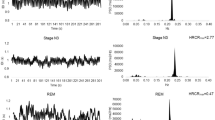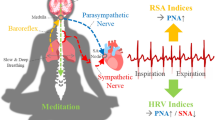Abstract
Purpose
Autonomic nervous system (ANS) activity can be non-invasively estimated from the heart rate variability (HRV) signal obtained from the electrocardiogram (ECG). The aim of this work is to find useful parameters that allow to establish the presence of a single night sleep deprivation in healthy subjects.
Methods
The study included two experimental groups of subjects: Non-sleep-deprived (sleep ≥ 4 h, N = 13) and sleep-deprived (sleep <4 h, N = 10). The RR series extracted from 5 min resting ECG signals were pre-processed using four different algorithms to detect and edit artifacts. The RR series were analyzed in terms of time-domain, frequency-domain and using the Poincaré plot, in order to determine differences in HRV indexes across domains and subject groups. Statistical analyses were performed with the Friedman and Mann–Whitney tests, along, with correlation analysis.
Results
Pre-processing methods showed a moderate level of agreement. In subjects with 4 h of single-night sleep deprivation, results differed according to the selected method.
Conclusion
SD21 index derived from the Poincaré plot was the only HRV index showing differences between sleep-deprived and non-deprived subjects.


Similar content being viewed by others
References
Wild, C., Nichols, E., Battista, M., Stojanoski, B., & Owen, A. (2018). Dissociable effects of self-reported daily sleep duration on high-level cognitive abilities. Sleep, 41(12), 1–11.
Taylor, A. H., & Dorn, L. (2006). Stress, fatigue, health, and risk of road traffic accidents among professional drivers: The contribution of physical inactivity. Annual Review Public Health, 27(1), 371–391.
Alhola, P., & Polo-Kantola, P. (2007). Sleep deprivation: Impact on cognitive performance. Neuropsychiatric Disease Treatment, 3(5), 553–67.
Lo, J. C., Groeger, J. A., Santhi, N., Arbon, E. L., Lazar, A. S., Hasan, S., et al. (2012). Effects of partial and acute total sleep deprivation on performance across cognitive domains, individuals and circadian phase. PLoS ONE, 7, 45987. https://doi.org/10.1371/journal.pone.0045987.
Lowe, C. J., Safati, A., & Hall, P. A. (2007). The neurocognitive consequences of sleep restriction: A meta-analytic review. Neuroscience & Biobehavioral Reviews, 80, 586–604. https://doi.org/10.1016/j.neubiorev.2017.07.010.
Banerjee, I., Ho Lee, J., Jang, K., Pande, S., & Ragland, D.R. (2009). Rest Areas-Reducing Accidents Involving Driver Fatigue. UC Berkeley Traffic Safety Center. Retrieved August 31, 220, from https://dot.ca.gov/-/media/dot-media/programs/research-innovation-system-information/documents/final-reports/ca09-1092-finalreport-a11y.pdf.
Chiu, C. C., Chuang, C. M., & Hsu, C. Y. (2009). Discrete wavelet transform applied on personal identity verification with ECG signal. International Journal of Wavelets, Multiresolution and Information Processing, 7(3), 341–355.
Vigo, D. E., Ogrinz, B., Wan, L., Bersenev, E., Tuerlinckx, F., Van Den Bergh, O., et al. (2012). Sleep-wake differences in heart rate variability during a 105-day simulated mission to Mars. Aviation Space and Environmental Medicine, 83(2), 125–30.
Buendia, R., Forcolin, F., Karlsson, J., Arne Sjöqvist, B., Anund, A., & Candefjord, S. (2019). Deriving heart rate variability indices from cardiac monitoring-An indicator of driver sleepiness. Traffic Injury Prevention, 20(3), 249–254.
Vicente, J., Laguna, P., Bartra, A., & Bailón, R. (2016). Drowsiness detection using heart rate variability. Medical and Biological Engineering and Computing, 54(6), 927–937.
Forcolin, F., Buendia, R., Candefjord, S., Karlsson, J., Sjöqvist, B. A., & Anund, A. (2018). Comparison of outlier heartbeat identification and spectral transformation strategies for deriving heart rate variability indices for drivers at different stages of sleepiness. Traffic Injury Prevention, 19(S1), S111–S119.
Peltola, M. A. (2012). Role of editing of R-R intervals in the analysis of heart rate variability. Frontiers in Physiology, 3, 148. https://doi.org/10.3389/fphys.2012.00148.
Malik, M., & Camm, J. (1995). Heart rate variability. New York: Futura Publishing Company Inc.
Camm, J. (1996). Guidelines heart rate variability. European Heart Journal, 17, 354–381.
Choi, A., & Shin, H. (2018). Quantitative analysis of the effect of an ectopic beat on the heart rate variability in the resting condition. Frontiers in Physiology, 9, 922. https://doi.org/10.3389/fphys.2018.00922.
Sathyapriya, L., Murali, L., & Manigandan, T. (2015). Analysis and detection R-peak detection using Modified Pan-Tompkins algorithm. In IEEE International Conference on Advanced Communications, Control and Computing Technologies.. https://doi.org/10.1109/ICACCCT.2014.7019490.
Aubert, A. E., Ramaekers, D., & Beckers, F. (1999). Analysis of heart rate variability in unrestrained rats, assessment of method and results. Journal of Medical and Biological Engineering, 60, 197–213.
Kemper, K. J., Hamilton, C., & Atkinson, M. (2007). Heart rate variability: Impact of differences in outlier identification and management strategies on common measures in three clinical populations. Pediatric Research, 62(3), 337–342.
McNames, J., Thong, T., & Aboy, M. (2004). Impulse rejection filter for artifact removal in spectral analysis of biomedical signals. In The 26th Annual International Conference of the IEEE Engineering in Medicine and Biology Society. https://doi.org/10.1109/IEMBS.2004.1403112.
Thuraisingham, R. A. (2006). Preprocessing RR interval time series for heart rate variability analysis and estimates of standard deviation of RR intervals. Computer Methods and Programs in Biomedicine, 83(1), 78–82.
Mishra, A., & Swati, D. (2015). The recursive combination filter approach of pre-processing for the estimation of standard deviation of RR series. Australasian Physical & Engineering Sciences in Medicine, 38(3), 413–423.
Rincon Soler, A. I., Silva, L. E. V., Fazan, R., & Murta Junior, L. O. (2017). The impact of artifact correction methods of RR series on heart rate variability parameters. Journal of Applied Physiology, 124(3), 646–652.
Wejer, D., Makowiec, D., Struzik, Z., et al. (2014). Impact of the editing of patterns with abnormal RR intervals on the assessment of heart rate variability. Acta Physica Polonica B, 45(11), 2103.
Laguna, P., Moody, G. B., & Mark, R. G. (1998). Power spectral density of unevenly sampled data by least-square analysis: Performance and application to heart rate signals. IEEE Transactions on Biomedical Engineering, 45(6), 698–715.
Saini, B. S., Singh, D., Uddin, M., & Kumar, V. (2008). Improved power spectrum estimation for RR-interval time series. International Journal of Electrical, Computer, Energetic, Electronic and Communication Engineering, 2(10), 154–158.
Stein, P. K., Domitrovich, P. P., Huikuri, H. V., & Kleiger, R. E. (2005). Traditional and nonlinear heart rate variability are each independently associated with mortality after myocardial infarction. Journal of Cardiovascular Electrophysiology, 16(1), 13–20.
Guzik, P., Piskorski, J., Krauze, T., Schneider, R., Wesseling, K. H., Wykretowicz, A., et al. (2007). Correlations between the Poincaré Plot and Conventional Heart Rate Variability Parameters Assessed during Paced Breathing. Journal of Physiological Sciences, 57(1), 63–71.
Hsu, C. H., Tsai, M. Y., Huang, G. S., Lin, T. C., Chen, K. P., Ho, S. T., et al. (2012). Poincaré plot indexes of heart rate variability detect dynamic autonomic modulation during general anesthesia induction. Acta Anaesthesiologica Taiwanica, 50(1), 12–18.
Hoshi, R. A., Pastre, C. M., Vanderlei, L. C. M., & Godoy, M. F. (2013). Poincaré plot indexes of heart rate variability: Relationships with other nonlinear variables. Autonomic Neuroscience: Basic and Clinical, 177(2), 271–274.
Mann, H. B., & Whitney, D. R. (1947). On a test of whether one of two random variables is stochastically larger than the other. Annals of Mathematical Statistics, 18(1), 50–60.
Salo, M. A., Huikuri, H. V., & Seppanen, T. (2001). Ectopic beats in heart rate variability analysis: Effects of editing on time and frequency domain measures. Annals Noninvasive Electrocardiology, 6(1), 5–17.
Dimitriev, D. A., Saperova, E. V., & Dimitriev, A. D. (2016). State anxiety and nonlinear dynamics of heart rate variability in students. PLoS ONE, 11, e0146131. https://doi.org/10.1371/journal.pone.0146131.
Acknowledgements
This study was supported by a grant from Agencia Nacional de Promoción Científica y Tecnológica (PICT Start-Up 2013-0710) and the 4th Research Project Accreditation Program (PROAPI) from Catholic University of Argentina (UCA).
Author information
Authors and Affiliations
Corresponding author
Ethics declarations
Conflict of interest
The authors declare no potential conflicts of interest with respect to the research, authorship, and/or publication of this article.
Ethical Approval
This study went through ethics approval from the Research Committee at National University of Quilmes, Buenos Aires, Argentina (04/07/2016/No. 3).
Consent for Publication
The Author warrants and represents that the Contribution does not infringe upon any copyright or other rights, and that it does not contain infringing or other unlawful matter, that he/she was the sole and exclusive owner of the rights herein conveyed to the Publisher.
Informed Consent
Informed consent was obtained from all individual participants included in the study.
Rights and permissions
About this article
Cite this article
Gallardo, J., Bellone, G., Plano, S. et al. Heart Rate Variability: Influence of Pre-processing Methods in Identifying Single-Night Sleep-Deprived Subjects. J. Med. Biol. Eng. 41, 224–230 (2021). https://doi.org/10.1007/s40846-020-00595-8
Received:
Accepted:
Published:
Issue Date:
DOI: https://doi.org/10.1007/s40846-020-00595-8




